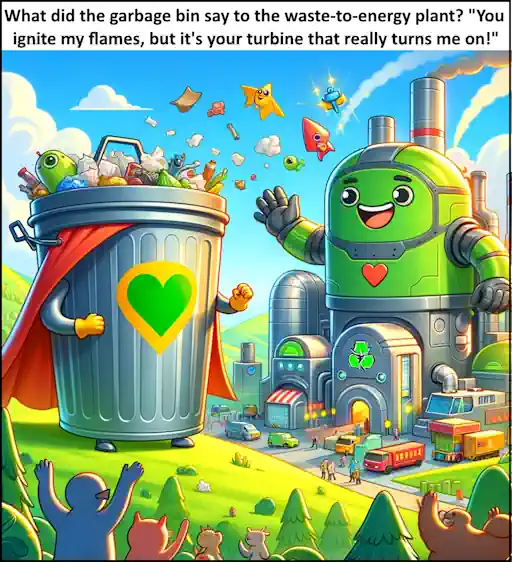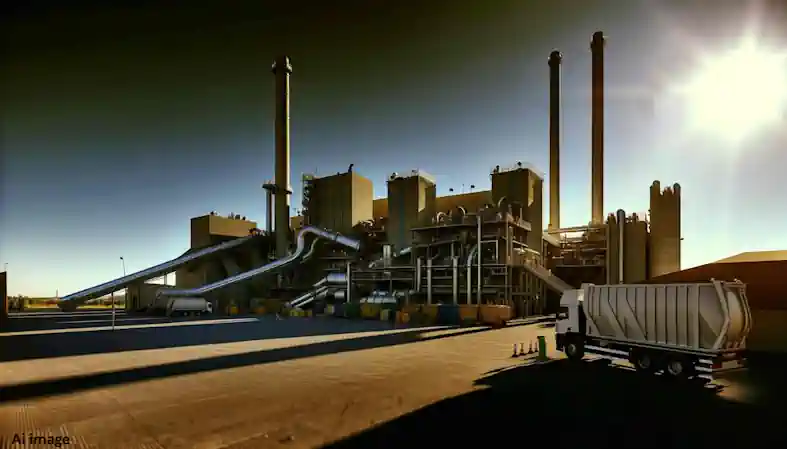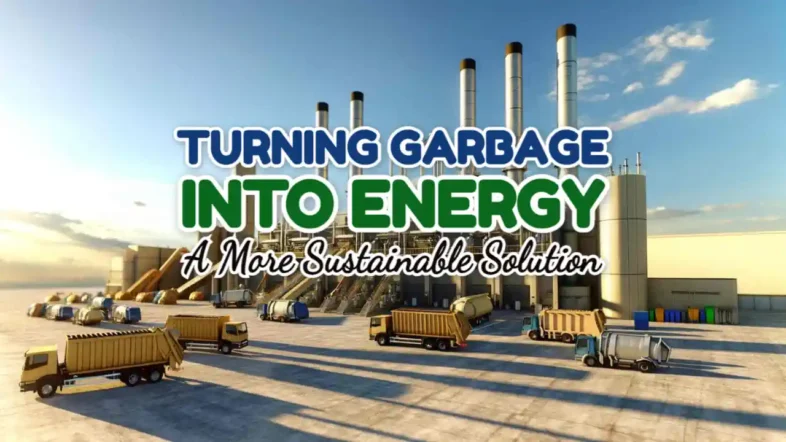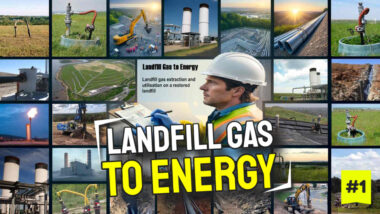Turning garbage into energy is also a way of recycling waste into usable energy. It is called “energy extraction” in the waste management industry, and it's a greener alternative to landfilling. In the battle to reduce global warming, it is a useful transition technology.
Addressing the colossal challenge of waste management, many find themselves at a loss. Surprisingly, waste-to-energy plants can transform your everyday rubbish into a valuable energy source.
This article will explore innovative solutions that convert what's typically seen as useless garbage into a powerful means to generate electricity and heat, offering you insights into creating a more sustainable future.
Let’s delve in and discover how trash is becoming treasure.
Key Takeaways
- By transforming garbage into usable energy, waste-to-energy plants reduce landfill waste by up to 87%. Methane is a dangerously high atmospheric-warming greenhouse gas, and this technology helps combat it by limiting its emissions.
- Sweden leads the way in waste-to-energy conversion, with 34 facilities turning trash into electricity and heating. The country aims for renewable energy by 2040 and no greenhouse gases by 2045.
- Best practices in converting garbage to energy include using advanced incineration technologies, sorting waste properly, turning organic waste into biogas, and involving communities in recycling programs.
- Innovations like plasma – enhanced gasification offer a cleaner way to create fuel from waste without harmful pollutants. This shapes a future where trash becomes an asset for producing clean energy.
- Common questions show that people are interested in how waste turns into power, its benefits for the environment, and the technology involved. Advanced methods like anaerobic digestion and pyrolysis play key roles.
Understanding Waste-to-Energy Conversion
Shifting gears from the introductory concepts, waste-to-energy conversion emerges as a crucial process in sustainable waste management. This approach takes municipal solid waste, which includes everyday items discarded by the public such as packaging, food scraps, and yard waste, and transforms it into valuable electricity and heat.
The heart of this system lies in its ability to reduce reliance on landfills while producing green energy.
Waste-to-energy plants primarily function by incinerating garbage under controlled conditions. Through this combustion, they generate steam that powers turbines, subsequently creating electricity.
Remarkably, these facilities can slash the volume of rubbish sent to dumps by roughly 87%. Not only does this method drastically cut down on landfill space required for municipal waste disposal but it also harnesses something usually seen as worthless—garbage—to fuel our cities sustainably.

The Importance of Turning Waste into Energy
Turning waste into energy addresses two major issues: reducing the volume of waste for landfill and slashing greenhouse gas emissions. Waste-to-energy plants can cut down garbage to ash, reducing its volume by about 87%.

This significant reduction not only alleviates pressure on landfills but also curbs methane production, a potent greenhouse gas released from decomposing waste. By turning trash into green electricity or biofuels, we're attacking the problem of climate change head-on.
This process transforms a pressing problem into a valuable resource. Instead of allowing organic waste and single-use plastics to pile up, converting them into renewable energy supplies homes and industries with cleaner power options.
It's a critical step towards building more sustainable urban environments where waste management contributes positively to energy infrastructure. Through techniques like anaerobic digestion and gasification, we unlock the potential of everyday rubbish, turning it into something that powers our lives rather than pollutes our planet.
The main disadvantage is that, although the cost of incineration is offset by the income from selling the energy, it is still an expensive waste disposal method, and must be paid for by ratepayers.
Real-World Examples of Waste-to-Energy Practices
Sweden shines as a global leader in turning trash into treasure, showcasing innovative approaches to waste-to-energy conversion — Dive deeper to uncover how they do it.

Sweden's approach to utilizing waste and turning garbage into energy
Sweden stands out due to its effective waste-to-energy power plants. The country boasts 34 facilities that are already turning garbage into energy. That's rubbish into electricity and heating, showcasing a successful model of energy from waste.
During the colder months, this strategy provides a sizable portion of the heat that Sweden's nearly 10 million residents require. By burning rubbish, these plants manage to harness about 90% of the total energy, which then provides hot water for bathrooms, kitchens, and central heating systems across the nation.
To slash methane emissions, Sweden banned organic and combustible waste in landfills between 2002 and 2005. This move not only mitigated harmful greenhouse gas emissions but also steered the country towards more sustainable waste management practices.
Currently focusing on ramping up recycling efforts, Sweden aims for a future powered entirely by renewable energy by 2040 and reaching net zero greenhouse gas emissions by 2045.
Transitioning now to best practices for converting waste into energy can provide insights into how other countries might replicate Sweden’s success on a global scale.
Best Practices for Converting Waste into Energy
Turning rubbish into energy isn't just an idea; it's a reality that's helping the planet. From reducing landfill sizes to generating clean power, the benefits are clear. Here are some of the best practices:
- Opt for Advanced Incineration Technologies: Modern incinerators reduce waste volume by about 87%. They’re equipped with filters and scrubbers to trap pollutants, ensuring air quality remains high.
- Implement Strict Sorting Policies: Before waste even reaches a plant, it should be sorted. Recyclable materials like plastics and metals can be removed and reused. This process ensures only non-recyclable waste goes to energy plants.
- Use Anaerobic Digestion for Organic Waste: Kitchen scraps and agricultural waste turn into biogas in biodigesters. This method is perfect for producing renewable natural gas while also creating digestate, a nutrient-rich fertiliser.
- Adopt Gasification for Cleaner Fuel Production: A gasifier turns waste into syngas, which can be used to generate electricity or as a basis for synthetic fuels like methanol, reducing reliance on fossil fuels.
- Promote Community Engagement and Education: Successful projects inform citizens about proper waste disposal and the benefits of waste-to-energy conversion. When communities understand the value, they’re more likely to support and participate in these initiatives.
- Ensure Proper Waste Stream Management: Organised infrastructure and logistics are crucial for moving waste from where it’s collected to where it will be converted into energy efficiently.
- Invest in Research for Continuous Improvement: The field is always advancing, so staying informed about the latest recycling technologies and methods is key to enhancing efficiency and sustainability.
- Collaborate Across Sectors: Partnerships between government bodies, private companies, and research institutions foster innovation in waste conversion technologies while ensuring projects have strong governance.
- Prioritise Energy Recovery from Hazardous Waste Safely: With strict controls, even hazardous waste can contribute to energy production without harming human health or the environment.
- Incorporate Public-Private Partnerships (PPPs): These agreements can provide the necessary funding and expertise for large-scale projects while spreading financial risk between public entities and private companies.

The Future of Waste-to-Energy: Trends and Opportunities
The future of waste-to-energy is bright, with innovations leading the way to more sustainable and efficient processes. Plasma-enhanced gasification, such as InEnTec's system, represents a significant leap forward for turning garbage into energy, although most municipalities won't choose his technology..
This technology converts waste into clean fuel without emitting toxic pollutants or producing hazardous ash. It points towards a cleaner, greener approach to managing waste and generating energy.
Emerging trends also indicate a shift towards integrating circular economies and improving resource recovery. Efforts are ramping up in creating renewable fuels from refuse-derived fuels, biogas production from organic wastes like food and kitchen waste, and electricity production through advanced gasification plants.
These advancements not only help reduce greenhouse gases but also play a crucial role in addressing climate change by turning rubbish dumps into sources of valuable energy.

The Spittelau Waste Incineration Plant in Vienna, Austria, served as inspiration for the AI visualization above, which highlights its distinctive architectural features and artistic design.
This visual representation showcases the plant's colorful facade, adorned with bright mosaic tiles, golden domes, and the integration of greenery, reflecting Friedensreich Hundertwasser's vision of blending industrial functionality with artistic creativity and environmental commitment. See the real Spittelau Waste Incineration Plant here.

The final word on turning garbage into energy
Garbage isn't just rubbish—it's a goldmine of energy waiting to be harnessed. Through clever processes, we've learned how to transform waste into power that lights up our homes and heats our water.
This shift towards greener energy not only battles climate change but also clears our lands of unwanted trash.
It's high time we all see the value in what we too often discard, recognizing waste-to-energy as a cornerstone for sustainable living.
Let's embrace this brighter, cleaner future together.

FAQs about turning garbage into energy
1. What exactly is energy from waste?
Energy from waste means taking what we usually throw away – like rubbish – and turning it into electricity or heat. This process can involve burning the waste or turning it into a gas called synthesis gas, which can then be used to produce greener energy.
2. How does this help our planet?
By turning rubbish into energy, we're doing two great things for Earth. First, we're making less trash pile up in landfills, which is better for our land and air. Second, by creating energy this way, we help fight climate change since it's a cleaner option compared to some traditional ways of getting power.
3. Are there any cool technologies involved?
Yes! Scientists at places like the Pacific Northwest National Laboratory are working on amazing tech that helps turn waste into ionized gases without harming the environment. This kind of fusion research is key to making waste-to-energy even more efficient and eco-friendly.
4. Can I do anything at home to support energy from waste?
Absolutely! You can start by following the three Rs: reduce, reuse, recycle. The less waste you create in the first place, the better! Also consider using products made from recycled materials and composting food scraps instead of throwing them away – every little bit helps!
5. Is converting rubbish to energy better than other renewable sources?
While not a one-size-fits-all solution, converting rubbish into energy plays an important role alongside other renewable sources like solar or wind power. It's especially useful because it tackles two problems at once: reducing landfill use and generating clean power.







